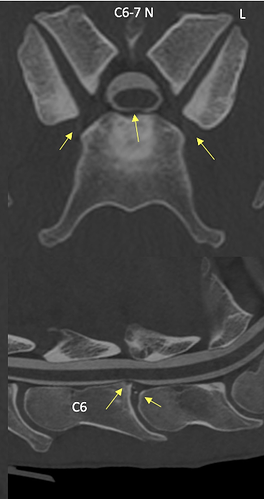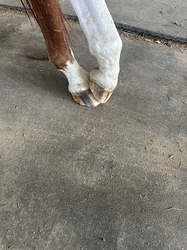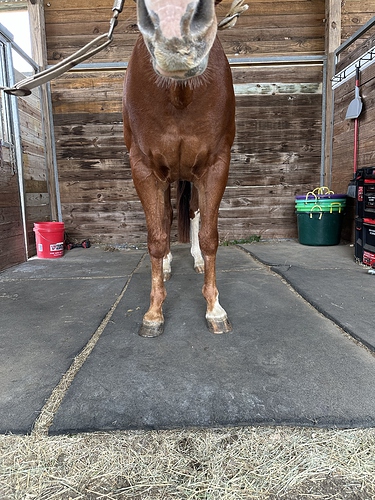Explosive behavior with the farrier, rearing, bucking, buckling, falling…all of these things he’s doing that aren’t normal…are symptoms.
And they are somewhat intermittent without a rider, actually improved from where we started 3 years ago. It is restricted to tight bends/the canter/riding. The farrier thing is literally brand new. He’s been a very happy retired pasture puff with zero instances of behavior until 6 weeks ago, where it was once and done. It wasn’t until a couple of days ago that it was repeated.
This doesn’t make them not symptoms.
That he can avoid triggering whatever is wrong with him when he’s loose in a field doesn’t mean there’s not something still seriously wrong with him.
Inability to stand politely for the farrier is still a symptom of his problems, even if it’s relatively new.
Which is why I’m here trying to pick people’s brains about what else I can discuss with the vet next week. It’s not a question as to if there is something wrong. The behavior is well documented, the root cause and if it can be managed has not been. The one thing he is not presenting, is consistent pain outside of the random explosions and consistent muscle tightness. The explosions are very far apart, but they happen. It’s not a simple matter of positioning either because he gets consistently manipulated and he’ll even turn himself into a pretzel to scratch.
He has a LOT he’s presenting, depending on circumstance.
Why do you think his previous issues are no longer issues for him, or indicative of what is wrong? These are ALL pieces to his puzzle.
It sounds very much like a pretty severe neurological problem.
Because they have all improved over the last three years. He tweaks them, and they re-surface here and there, sometimes severely, they haven’t completely gone away, but much improved. Sometimes I know what conditions set him off, and sometimes I don’t. He’s foot perfect, until he isn’t. When he isn’t, it is dangerous, and it’s out of the blue enough to have caught several professionals off guard.
I’m afraid this sounds like either 1) neurological issues or 2) a muscle disease like pssm 2.
I will say the muscle diseases tend to cause canter issues and can in some cases progress to neurological issues.
Let me elaborate on my mare with muscles issues
-
she could not hold the canter lead without crow hopping and swapping leads behind. In general she can hold the lead on a straight line and if you canter immediately (and skip warm up), she can hold the canter lead for a longer period without struggling. She has never been explosive and tried to get a rider off, but she gets progressively more uncomfortable if you continue.
-
she did not present with tie up episodes until later in life.
-
one vet told me she was not lame enough to diagnose and I should work her harder… working her harder only improved her soundness. The more she is worked on a daily basis the better her canter gets.
-
she gets progressively more tired as you ride where it gets harder and harder for her to pick up her feet and she can’t stand for the farrier after riding because her muscles get too tight behind.
-
for the most part she’s not painful. I think it’s more of a mechanical lameness as her muscles get tight. She gets stiff as her muscles get tight but she’s not limping or really showing signs of pain unless she has a tie up episode.
-
sometimes she is absolutely fine and symptom free and you can ride her for longer periods without any symptoms at all. Usually it’s a combination of a low sugar diet and better weather. She really struggles with hot weather and is sensitive to cold but is fine with a blanket.
I don’t think all muscle diseases are the same, as some present with muscle soreness and pain. Some are more violent in their reactions. I had one paint horse that would tie up just standing in the field. That horse could not keep weight on for anything and was highly symptomatic. I was pouring feed into her and wondering why her condition wasn’t better. Not sure what happened to her as her owner took her back rather then seek veterinary care. The day I found her tied up in the field her abdominal muscles were all tucked up and she was staggering. I was afraid to put her in the barn because I thought she would go down and we wouldn’t be able to get her up again. It was scary.
If you haven’t looked at some of these videos, I would and perhaps see if anything can be adjusted in the diet.
Are you considering euthanasia? Since your horse definitely seems to have multiple issues, that is a reasonable conclusion but if these things can be safely managed that is where I would start.
If it is a muscle disease, you can do a muscle biopsy and test vitamin E (but my vet wants a ridiculous amount of money for that) so I opted to treat instead. My mare is 21 yrs old this year so a diagnosis probably won’t change what I do for treatment.
So you’ve been riding him? And he’s foot perfect?
Based on what you posted, it seems his QOL has declined enough that basic care is putting humans in harms way.
I would discuss with the vet doing a Hail Mary with injections in the neck, muscle relaxers, pain meds, and if still dangerous and explosive, discuss euthanasia.
No horse is worth putting another humans life at risk.
Absolutely not since we got him. But he did spend time with a trainer about two years ago to determine if our bucking issues were physical or behavioral. He was absolutely foot perfect for her, until he wasn’t. I saw it in person. I rode him, my kid rode him, other people’s kid rode him, even jumped him. He was a favorite of the working students. Until the first cold snap of the year came in and he started bucking and rearing at the mounting block within a week. That experiment ended when he wound up exploding in the trailer, over the chest bar with both legs and then going over backwards before twisting around and walking out….to spend the rest of the day tied to the trailer like a perfect gentleman.
He’s been perfect for the vets, except for the one lameness. He’s been perfect for the chiro and the bodyworkers. And up until recently he’s been very well behaved for the farrier. So, yeah. He’s been described as foot perfect and not by me.
Narrowing his life and what you ask to avoid things that trigger his dangerous behaviors doesn’t mean those problems are solved.
Truly, it sounds like you’ve done a good job of allowing him to do what’s okay for him by limiting what you ask. Now you’ve run into something that’s not really optional, and he’s progressed so that basic care is not okay.
I’m very sorry. It sucks a lot when there’s a progressive problem. At some point, there’s just a point where you just can’t ask any less.
Not immediately, but ultimately if I can’t get him back to reasonable, yes, euthanasia is on the table.
Anyway, I’ve long suggested PSSM and everyone else has said no. It’s been my theory for a while that the muscle tightness pulls on his spine or is somehow caused by nerve issues. But what do I know.
I never said they were solved. I said he had improved. And he has, in ways that are measurable and obvious to others. I also said he was “fine” until he wasn’t and that when he wasn’t it was unpredictable, explosive, and violent.
Looking at CT scans of horses with neck issues, especially narrowing or pressing on the spinal cord it’s easy to imagine things feeling okay for them then suddenly they have an unbearable zinger. If its arthritis, it is a progressive issue, so there definitely could be a worsening of symptoms. The “foreleg pulled to the front by the farrier” symptom being unbearable is one of the first symptoms my vet identified as neck related that led us to our local teaching hospital. x-rays revealed nothing, but ultrasound and ct myelogram showed exactly why my horse had issues. Stumbling, falling, difficulty going on the bit, difficulty for the farrier, unpredictable behavior that seems to turn itself off/on in an instant are all signs of severe neurological disease.
It very much sounds like he’s getting big, nervy zingers.
That’s like getting electrocuted from the inside.
Does that help to frame his behavior in an understandable way? Yes, it makes them unpredictable, explosive and violent.
As someone who has walked and walks the fine line of QOL, including farrier issues… if addressing a few more chemical issues with the vet this week doesn’t answer questions I’d suggest humane euthanasia, kindly. My senior man was being trimmed behind upside down by my kind and apparently flexible and creative farrier because his DSLD made lifting and holding difficult, but resting on the stand was easy - but in the end it was MFing cancer. Odie is small enough he can physically tolerate a sling for the farrier (emotionally, well… ) so life goes on for him for now with equioxx. But I’m not above sedating horses that are being shits, because farriers don’t get paid sick days and horses that are dangerous like that need a second, third, and fourth look for the cause. You have an idea on the cause. You are taking what sounds like a fourth look, but I’m not sure in depth those other looks are and if you are riding him and why he needs shoes if he is this unpredictable and neurological?
) so life goes on for him for now with equioxx. But I’m not above sedating horses that are being shits, because farriers don’t get paid sick days and horses that are dangerous like that need a second, third, and fourth look for the cause. You have an idea on the cause. You are taking what sounds like a fourth look, but I’m not sure in depth those other looks are and if you are riding him and why he needs shoes if he is this unpredictable and neurological?
I hope you report back 
They are temporary to support hoof wall damage while it grows out. And seriously, he has been fine on the ground for two years now. His issues only come out sporadically on the ground, and consistently at speed or tight circles.
And yes, he’s actually improved. 90% of the time he no long stands camped under, stands hoof on hoof, bunny hops, cross canters, buckles, breaks gait, head flings or bucks in the canter at liberty or looks muscle wasted on his top line and he will actually stand more or less square over his strung out every foot in a line posture.
None of that changes the fact that when I retired him he was rearing, bucking, bunny hopping, head flinging, cross cantering, buckling, or braking gait at any attempt to canter, and had a couple of instances struggling to keep his feet under him at the canter on a lunge line.
Again, up at this point in time, he has always been solid for the farrier and basic handling to live a comfy retired life, he’s even improved with a lot of bodywork. He’s been happy, comfortable, and relatively safe to handle on the ground.
He can be like this, when he’s fully symptomatic, which is definitely neuro and not normal:
But he’s improved to be more often than not like this:
Then you have done right by him and perhaps the gate incident exacerbated something, so please report back!
Is he getting turnout? Does he self exercise during turnout? The best thing for a horse with muscle issues is movement and a low sugar diet. You can also experiment with adding extra fat and/or protein. Add vitamin e and selenium.
Some horses lose their mind in the trailer and do things like climb over the divider. I’m not sure all this is physical. There could be a mental aspect like pulling back on the cross ties.
My horse who pulled back was good 98% of the time when tied… but when something started her she would pull back. I have a horse now who decided she is afraid of standing next to the trailer and will only pull back in that one location. I have no idea why that became an issue as she was trailered many many times throughout her life and tied up many many times.





